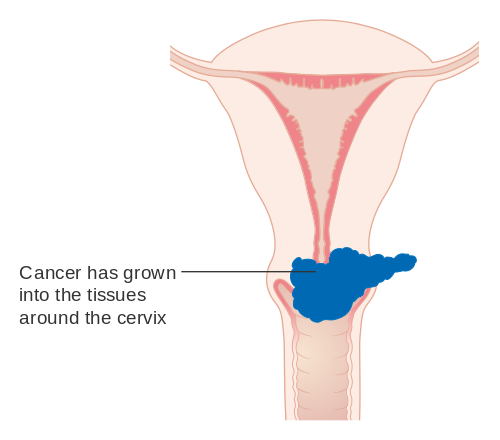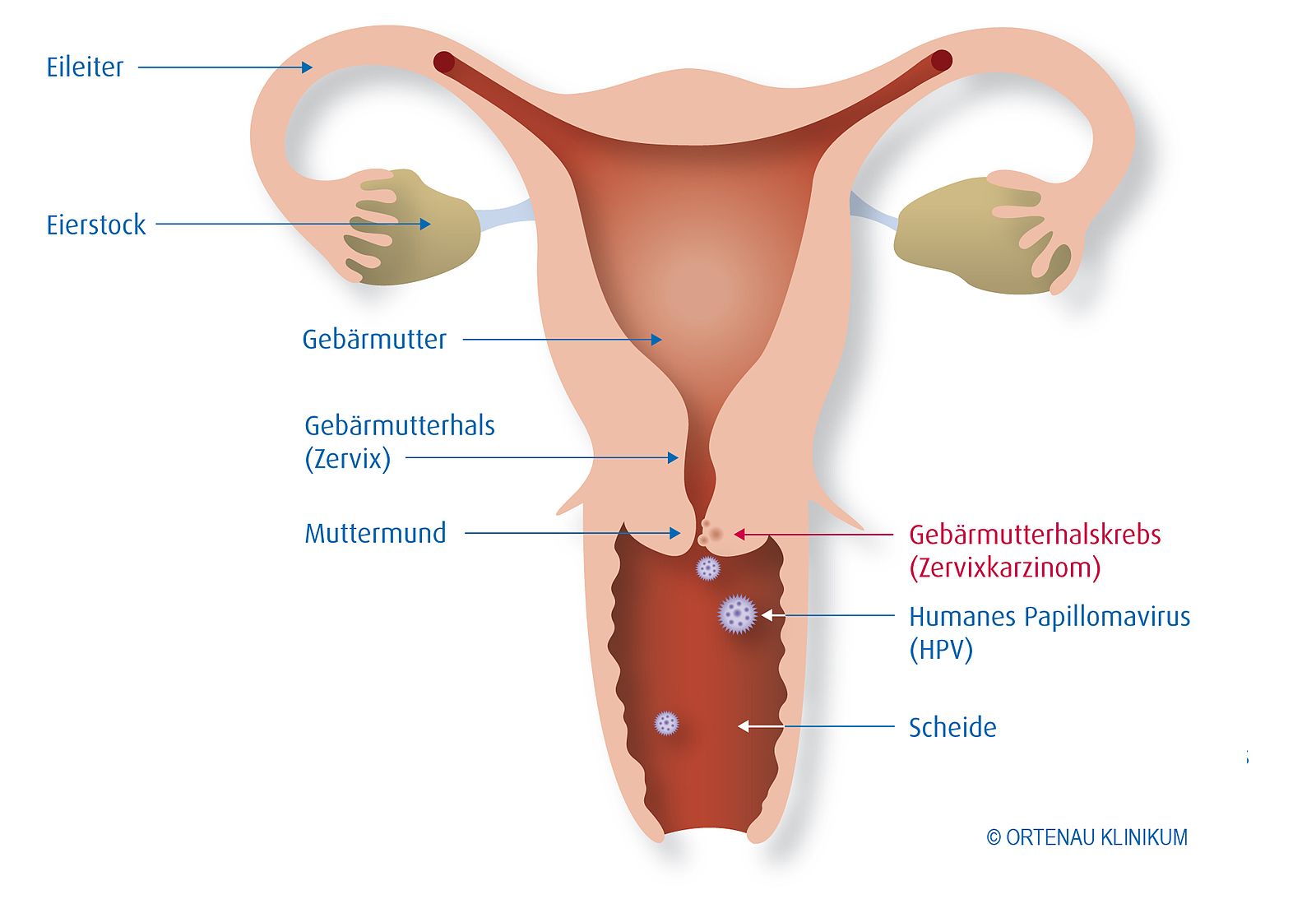Difference Between Cervical Cancer and HPV
What is Cervical Cancer?
Cervical cancer is a type of cancer that forms in the tissues of the organ connecting the uterus and vagina – the cervix.
Cervical cancer is one of the most common tumors of female genitalia. It affects women between 30 and 60 years of age.
Initially, the disease occurs without symptoms. They occur when adjacent organs are affected or when infiltration in the uterus occurs. The most common symptoms include:
- Bleeding(s) between normal menstruations;
- Bleeding after sexual intercourse or gynecological examination;
- Longer menstruations;
- Bleeding after menopause;
- Pain during sexual intercourse;
- Vaginal discharge;
- Pain in the leg;
- Pelvic pain;
- Overall weakness, etc.
Cervical cancer is caused by high-risk HPV (human papillomavirus) types which are found in 99.7% of cases.

Risk factors for the development of the disease include:
- HPV infection;
- Unsafe sex;
- Chlamydia infection;
- Immune disorders, such as HIV;
- Smoking;
- Unhealthy diet;
- Obesity;
- Taking oral contraceptives for a long time;
- Starting a sexual life early;
- Early pregnancy;
- Frequent change of sexual partners;
- Family burden with cervical cancer, etc.
The diagnosis is made by examination, Pap test, HPV – DNA test, and cervical biopsy.
The presence of pathological cells on the surface of the cervix is usually only detected with a Pap test (cervical screening). Regular gynecological examinations with a Pap test are necessary for early diagnosis of the disease.
Prior to the development of advanced forms of invasive cancer, various pre-cancerous lesions develop. If not treated, these lesions can lead to the development of cancer for 10-12 years in 30-70% of the cases. In 10% of patients, these lesions may progress to invasive forms in less than 1 year.
Based on the stage of the disease when diagnosed, the primary treatment for cervical cancer consists of surgical treatment, radiotherapy or a combination of radiotherapy and chemotherapy.
All sexually active women after the age of 21 should undergo regular prophylactic gynecological examinations with a Pap test at least every 2 years.
There is a vaccine against the four most common types of HPV (6, 11, 16 and 18). The vaccine is intended for girls and young women between the ages of 9 and 26 years and should be applied before the first sexual intercourse. It is effective only before the person is exposed to HPV infection.

What is HPV?
HPV are double-stranded DNA viruses of the Papilomaviridae family. They are classified by numbers, according to the order of their discovery. HPV are a widely spread viruses affecting the skin and mucous membranes and causing many diseases, including cervical cancer.
More than 100 types of HPV are known. About 40 of them are associated with infections in the genital area.
Genital HPV types are categorized according to their epidemiological relationship to cervical cancer:
- Low Risk Types – 6, 11, 42, 43, 44. They are associated with a low risk of progression to cervical cancer. They can cause of benign cervical lesions, genital condylomas or recurrent respiratory papillomatosis.
- High Risk Types – 16, 18, 31, 33, 35, 39, 45, 51, 52, 56, 58, 59, 66. High-risk viral types are associated with an extremely high risk of cancer development. They cause cervical lesions and invasive carcinoma.
The HPV are highly resistant to external conditions and thus – widespread. They affect men, women, and children.
Infection occurs by contact, autoinoculation, sexual contact, transmission of maternal infection to the baby at birth. The presence of small wounds on the skin and mucous membranes facilitates inoculation.
HPV infection often occurs asymptomatically and does not cause any complaints in the majority of cases.
However, if there are symptoms, they usually develop within a few weeks to three months after inoculation. HPV strains 6 and 11 form cauliflower-like formations called “condylomas”, most commonly found in the genitals and around the anus. In other strains (16, 18, 33 and 35), small, thin, warts are formed at the site of infection.
Inoculated skin areas do not cause pain, but itching is possible. If the growths are larger, secretion and even bleeding are possible. Skin areas are usually wet, whitish to pink, gray or brown.
Most HPV strains do not cause disease, as the body’s immune system deals with them. However, when the infection persists for a long time, it can lead to:
- Benign genital tumors;
- Genital warts;
- Flat condylomas;
- Cervical precancerous conditions;
- Vaginal carcinoma;
- Cervical cancer;
- Cancer of the anus;
- Head and neck cancer;
- Common warts on the hands, fingers, and wrists – single or multiple, sometimes merging with each other.
- Plantar warts – small, with a rough surface and painful under pressure.
- Adolescent warts – mostly on the face, over time usually disappear spontaneously but may remain unchanged for years.
Every woman, after becoming sexually active, should have regular prophylactic examinations including a Pap test. The screening leads to early diagnosis and reduces the number of cervical cancer deaths by about 70%.
In modern HPV diagnostics, it is recommended to perform DNA analysis that provides maximum sensitivity and specificity. The test allows for direct detection of viral DNA in the sample. The study provides information about the patient’s HPV infection status, which is important in determining the course of treatment.
Different types of warts are removed by special chemicals, cryotherapy or electro-surgical intervention (with high voltage electricity).
There is a vaccine against the four most common types of HPV (6, 11, 16, and 18). The vaccine is intended for girls and young women between the ages of 9 and 26 years and should be given before the first sexual intercourse.
Difference Between Cervical Cancer and HPV
Definition
Cervical Cancer: Cervical cancer is a type of cancer that forms in the tissues of the organ connecting the uterus and vagina – the cervix.
HPV: HPV are double-stranded DNA viruses of the Papilomaviridae family, affecting the skin and mucous membranes and causing many diseases, including cervical cancer.
Occurrence
Cervical Cancer: Cervical cancer is one of the most common tumors of female genitalia. It affects women between 30 and 60 years of age.
HPV: The HPV are highly resistant to external conditions and thus – widespread. They affect men, women, and children.
Etiology
Cervical Cancer: Cervical cancer is caused by high-risk HPV types which are found in 99.7% of cases.
HPV: Infection occurs by contact, autoinoculation, sexual contact, transmission of maternal infection to the baby at birth.
Symptoms
Cervical Cancer: Symptoms occur when adjacent organs are affected or when infiltration in the uterus occurs. The most common symptoms include bleeding(s) between normal menstruations, after sexual intercourse, gynecological examination or after menopause, longer menstruations, pain in the leg, pelvic pain, overall weakness, etc.
HPV: HPV infection often occurs asymptomatically. Symptoms may include the formation of condylomas and warts at the site of infection, itching, secretion, wet, whitish to pink, gray or brown skin areas.
Diagnosis
Cervical Cancer: The diagnosis is made by examination, Pap test, HPV – DNA test, and cervical biopsy.
HPV: In modern HPV diagnostics, it is recommended to perform DNA analysis that provides maximum sensitivity and specificity. The test allows for direct detection of viral DNA in the sample.
Prevention and Treatment
Cervical Cancer: There is a vaccine against the most common types of HPV. Based on the stage of the disease when diagnosed, the primary treatment for cervical cancer consists of surgical treatment, chemotherapy, radiotherapy or a combination of radiotherapy and chemotherapy.
HPV: There is a vaccine against the most common types of HPV. Different types of warts and condylomas are removed by special chemicals, cryotherapy or electro-surgical intervention (with high voltage electricity). The treatment for cervical cancer consists of surgical treatment, chemotherapy, radiotherapy or a combination of radiotherapy and chemotherapy.
Cervical Cancer vs. HPV

Summary of Cervical Cancer vs. HPV:
- Cervical cancer is a type of cancer that forms in the tissues of the organ connecting the uterus and vagina – the cervix.
- HPV are double-stranded DNA viruses of the Papilomaviridae family, affecting the skin and mucous membranes and causing many diseases, including cervical cancer.
- Cervical cancer is one of the most common tumors of female genitalia. It affects women between 30 and 60 years of age. The HPV are highly resistant to external conditions and thus – widespread. They affect men, women, and children.
- Cervical cancer is caused by high-risk HPV types which are found in 99.7% of cases. Infection with HPV occurs by contact, autoinoculation, sexual contact, transmission of maternal infection to the baby at birth.
- The most common symptoms of cervical cancer include bleeding(s) between normal menstruations, after sexual intercourse, gynecological examination or after menopause, longer menstruations, pain in the leg, pelvic pain, overall weakness, etc. Symptoms of HPV infection may include the formation of condylomas and warts at the site of infection, itching, secretion, wet, whitish to pink, gray or brown skin areas.
- The diagnosis of cervical cancer is made by examination, Pap test, HPV – DNA test, and cervical biopsy. In modern HPV diagnostics, DNA analysis is recommended.
- The primary treatment for cervical cancer consists of surgical treatment, chemotherapy, radiotherapy or a combination of radiotherapy and chemotherapy. Different types of warts and condylomas are removed by special chemicals, cryotherapy or electro-surgical intervention (with high voltage electricity).
- Difference Between Gallstones and Cholecystitis - September 5, 2021
- Difference Between Constipation and Cramping - August 4, 2021
- Difference Between Whole Genome Sequencing and Microarray - May 6, 2021
Search DifferenceBetween.net :
Leave a Response
References :
[0]Image credit: https://upload.wikimedia.org/wikipedia/commons/thumb/f/f7/Diagram_showing_stage_2B_cervical_cancer_CRUK_216.svg/500px-Diagram_showing_stage_2B_cervical_cancer_CRUK_216.svg.png
[1]Image credit: https://de.wikipedia.org/wiki/Datei:Ortenau_Klinikum_Schaubild_Geb%C3%A4rmutterhalskrebs_Zervixkarzinom_HPV.jpg
[2]Cobo, F. Human Papillomavirus Infections. Amsterdam: Elsevier. 2012. Print.
[3]Markovic, N., O. Markovic. What Every Woman Should Know about Cervical Cancer: Revised and Updated 2nd Edition. Berlin: Springer. 2016. Print.
[4]Borruto, F., M. De Ridder. HPV and Cervical Cancer: Achievements in Prevention and Future Prospects. Berlin: Springer. 2012. Print.
